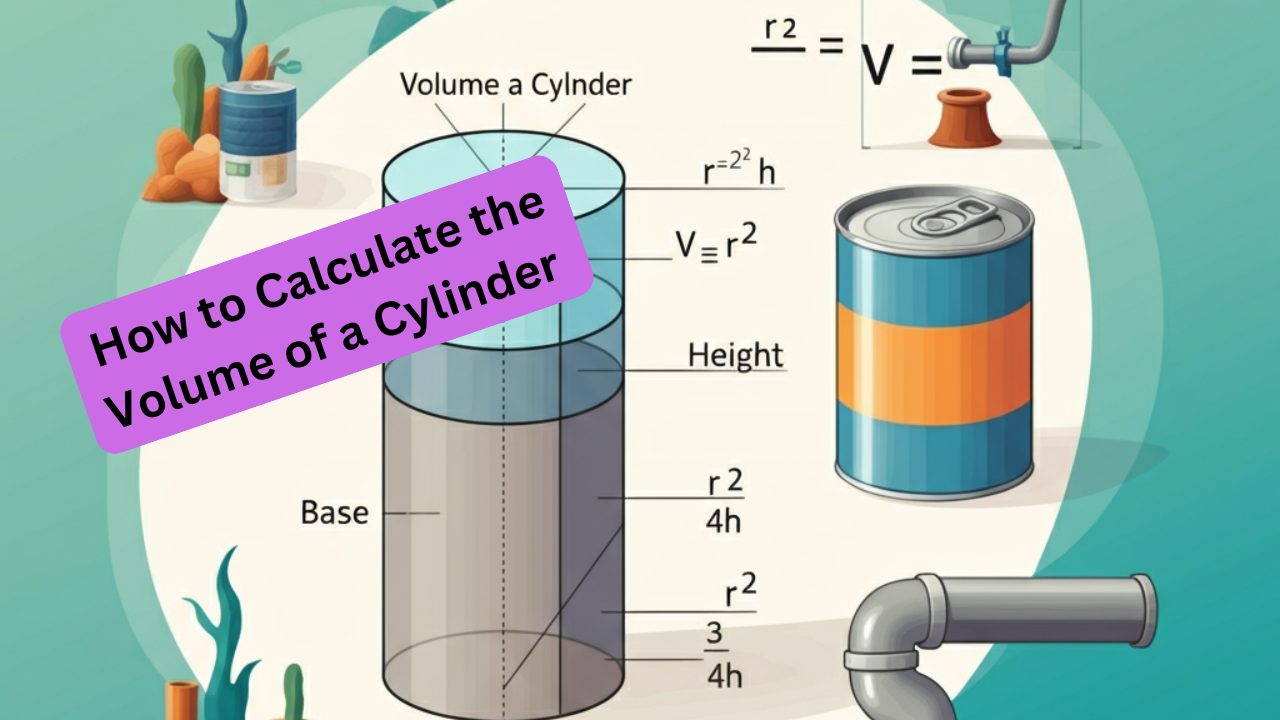When it comes to understanding 3D geometry, the Volume of a cylinder is one of the most practical and widely applicable concepts. Whether you’re a student tackling math problems, an engineer designing storage tanks, or someone calculating the capacity of a soda can, this topic plays a critical role.
This blog is your comprehensive guide to understanding the formula, calculating cylinder volume step-by-step, and exploring its real-world significance. We’ll also provide practice problems and tips and even touch on advanced concepts for enthusiasts. Let’s get started!
What Is a Cylinder?
A cylinder is a three-dimensional shape with two parallel circular bases of equal size connected by a curved surface. It is one of the simplest 3D shapes and is commonly seen around us.
Components of a Cylinder:
- Base: The circular surface at the top and bottom.
- Radius (r): The distance from the centre of the base to its edge.
- Height (h): The perpendicular distance between the two bases.
Key Difference From Other 3D Shapes:
- Unlike a cube or rectangular prism with flat faces, a cylinder has curved surfaces.
- Unlike a cone, the cylinder’s two bases are the same size and parallel.
Here’s a labelled diagram for easy understanding:
[Insert Diagram of a Cylinder with Labeled Radius and Height]
The Formula for Volume of a Cylinder
The Volume of a cylinder is calculated using the formula:
V = πr²h
Where:
- V = Volume of the cylinder.
- π = Pi (approximately 3.14159).
- r = Radius of the base.
- h = Height of the cylinder.
Breaking Down the Formula:
- πr² represents the area of the circular base.
- Multiplying this area by the Height (h) gives the total space (or Volume) the cylinder occupies.
Step-by-Step Guide to Calculating Cylinder Volume
Follow these steps to calculate the Volume of a cylinder:
Example:
Find the Volume of a cylinder with:
- Radius (r) = 4 cm.
- Height (h) = 10 cm.
- Note Down the Formula
V = πr²h
- Substitute Known Values
V = π × (4)² × 10
- Calculate the Circular Base Area (πr²)
V = π × 16 × 10
- Multiply by Height
V = π × 160
- Input the Value of π (3.14159)
V ≈ 502.65 cm³
The Volume of the cylinder is approximately 502.65 cubic centimetres.
You can also use online calculators for quicker results (we’ll list tools in the conclusion).
Real-World Applications of Cylinder Volume
Understanding how to calculate the Volume of a cylinder has countless practical uses. Here are a few:
- Everyday Use:
- Determining how much liquid a water tank can hold.
- Measuring the capacity of cylindrical containers like cans or bottles.
- Construction and Engineering:
- Calculating the Volume of pipes during plumbing projects.
- Designing storage tanks or silos.
- Manufacturing:
- Optimizing material used in producing cylindrical objects.
- Science Experiments and Research:
- Measuring the displacement in cylindrical solids or fluids.
Tips and Tricks for Accurate Calculations
- Always use the same units for radius and height (e.g., meters, centimetres). Convert them into consistent units if needed.
- If given the diameter, remember to divide it by 2 to find the radius.
- Show all steps when solving problems to avoid missing key details.
- Use accurate values of π (at least 3.14) for precise results.
- Cross-check your answers using an online calculator for confirmation.
Common Mistakes to Avoid:
- Forgetting to square the radius (r²).
- Using inconsistent units for radius and Height.
- Mixing up diameter and radius.
Advanced Topics
Once you’ve mastered the basics, explore these advanced concepts:
Hollow Cylinder Volume:
To calculate the Volume of a hollow cylinder:
- Subtract the smaller radius from the larger radius (outer – inner).
- Apply the formula for the remaining cylinder.
Oblique Cylinders:
For tilted or slanted cylinders, the Height used in the volume formula is the perpendicular Height, not the slant.
Using Calculus:
Integration is used to derive the formula for cylinder volume, enhancing your understanding of geometry and physics.
Surface Area:
The total surface area of a cylinder can be calculated using:
Surface Area = 2πr² + 2πrh
This formula includes both bases and the curved surface.
Practice Problems
Put your knowledge to the test with these problems:
- Find the Volume of a cylinder with radius = 5 cm and height = 12 cm.
- A pipe is hollow, with an outer radius = 7 m, an inner radius = 5 m, and a Height = 10 m. Calculate the Volume of the material used.
- Double the radius of a cylinder with initial radius = 3 m and height = 8 m. How does its volume change?
Answer Key:
- V ≈ 942 cm³
- V ≈ 376.99 m³
- Volume increases 4 times when the radius is doubled.
FAQ Section
How do I find the radius if I only know the diameter?
Divide the diameter by 2 to find the radius.
What units should I use for volume calculations?
Always ensure radius and Height are in the same units—Volume is typically expressed in cubic units (e.g., cm³, m³).
Can this formula be used for hollow cylinders?
Yes, but you need to subtract the Volume of the inner cylinder from the outer one.
How does the volume change if I double the radius?
Doubling the radius increases the Volume by 4 times (since r² is squared).
Where can I find online calculators for cylinder volume?
Sites like WolframAlpha or apps like GeoGebra offer online volume calculators.
What is the difference between Volume and surface area?
Volume measures the space inside a cylinder, while surface area measures the outer surface.
How is the Volume of a cylinder used in engineering?
It’s used for designing everything from storage tanks to piping systems.
Is the formula different for oblique cylinders?
No, but ensure you use the perpendicular Height, not the slant height.
Further Resources
Explore these math resources:
- “Geometry Made Easy” by John Doe (Book)
- WolframAlpha’s Cylinder Volume Calculator
Related post:
Pentagon shape-Definition,Properties,Types
20 cm to Inches – Easy Conversion Guide
Have questions? Drop a comment below! 🚀







